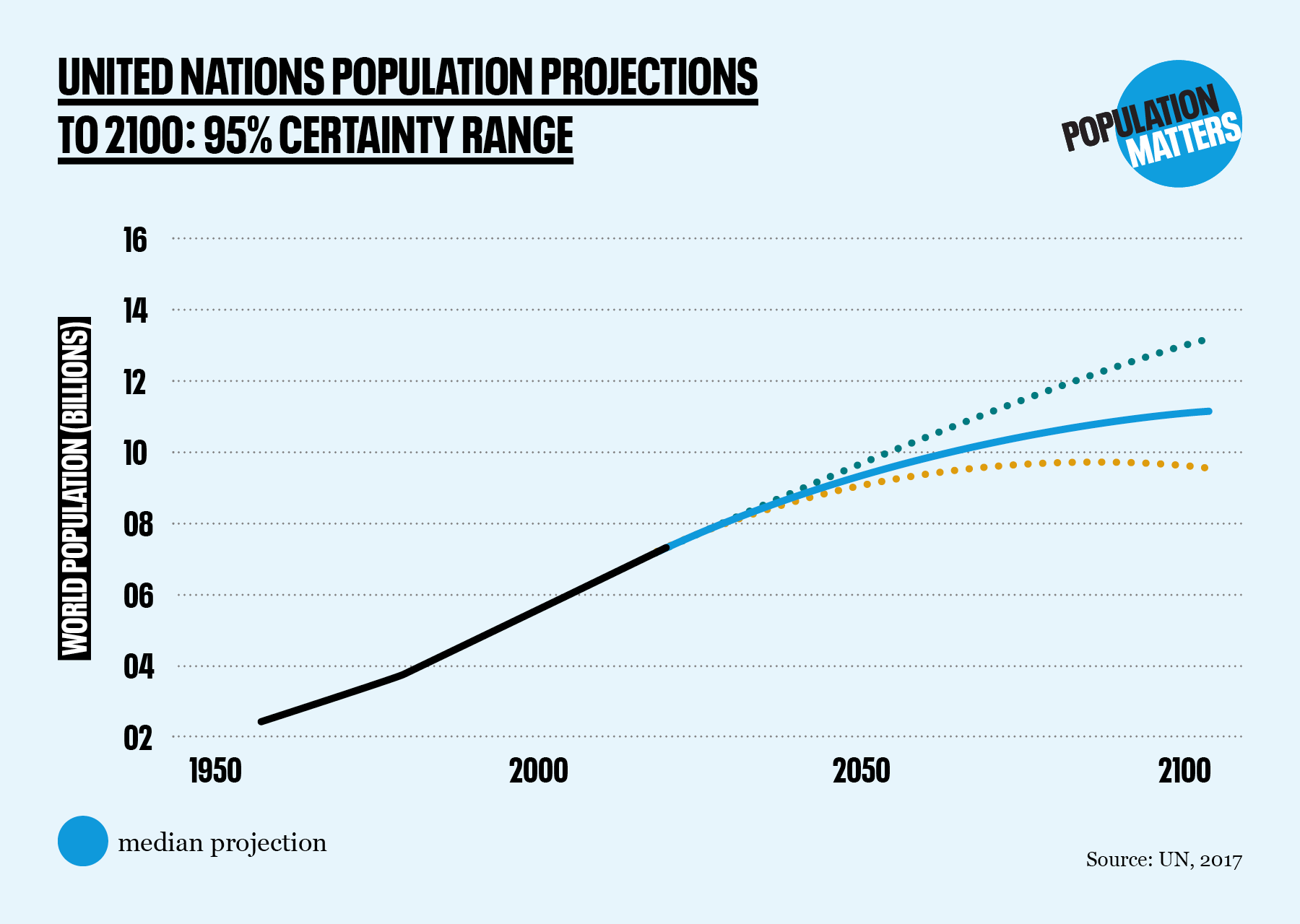
Will the world run out of people?
Empty Planet by Darrell Bricker and John Ibbitson makes the startling claim that far from increasing by billions as experts predict, global population will peak below 9 billion and start to fall by the middle of the century. The challenge the world will need to face, they say, is too few people, not too many.
Population Matters’ Head of Campaigns, Alistair Currie, asks if they could be right?
NOTE: This blog was originally written when the book was first published, on the basis of media reports, pre-publicity and interviews with the authors in which they outlined their case. Subsequent to its writing, we have read the book and our analysis is unchanged. For a more detailed review, please see this review in the Journal of Population and Sustainability.
Conventional wisdom
The world’s generally acknowledged leading authority on population growth is the United Nations. In 2017, its main projection was that global population is most likely to be 9.8bn by 2050 and 11.2bn by 2100 – though as the graph below shows, the range of likely figures is rather larger. The UN was also clear on population reduction, saying the chance of population growth ending before 2100 is only 27 per cent.

The UN’s projections are based on assumptions about factors such as future fertility (number of children each women will have), how many children will survive into adulthood and how long people with live. These assumptions are in turn informed by expert consideration of all the factors that affect them.
Empty Planet argues that those assumptions are wrong. Specifically, it maintains that rapid urbanisation in the Global South in particular will lead to people choosing smaller families far more rapidly than the UN assumes. People will make that choice because they will have better access to education, women will become more empowered, having fewer children is more advantageous in an urban environment than a rural one, and because increasing access to information through the internet and smart phones will shift cultural assumptions about family size far faster than has been the case in the past.
Is conventional wisdom wrong?
It might be. The world has seen unprecedented changes in recent years, and urbanisation does lead to reductions in Total Fertility Rate (this term refers not to the ability of people to have children, but the number they actually have). Fertility rates have fallen significantly in many places as a result of social and economic changes and active family planning programmes. That some of these trends might accelerate faster than expected in some places is entirely plausible.
Bricker and Ibbotson’s claims of a population peaking under 9bn by mid-century and then declining are more than just that some trends may be underestimated, however. Neither author is a demographer or population expert, and the book does not rely extensively on academic sources, namechecking only a handful of organisations and experts whose conclusions are largely in line with the authors’. Population Matters has not yet seen the data on which the authors rely and it clealy requires careful scrutiny. There is very good reason to treat the authors’ speculations with considerable caution.
Predicting the future
Firstly, the United Nations has no track record of over-predicting population growth. Indeed, until 2017, each projection it made for decades was revised upwards in the light of developments since the last one. (NOTE. The 2019 UN population projections, published after this blog was written, were revised downwards slightly, with the projected 2050 global population shifted from 9.8bn to 9.7bn.) There are various reasons for this, but they include people living longer than anticipated and fertility rates in some regions falling more slowly than anticipated.
Indeed, in some places, falls in fertility rate have almost entirely stopped, defying assumptions that increasing development in poor countries will see changes similar to those which took place in the developed world as it industrialised. A very recent study highlights how stalled improvements in education provision in Africa have contributed to some increases in family size.
There are also active forces working against smaller family sizes at present. While increasing affluence, women’s empowerment and education all contribute significantly to reductions in family size, what does the heavy lifting is effective family planning.
In the words of the UN:
To achieve the substantial reductions in [projected] fertility … it will be essential to support continued improvements in access to reproductive health care services, including family planning, especially in the least developed countries, with a focus on enabling women and couples to achieve their desired family size.” [Emphasis added.]
However, the key global family planning uptake target set in 2012 is now very unlikely to be met, while provision is under additional pressures such as the cuts in US funding to family planning domestically and internationally. Abortion access is also under threat from government policies in some countries. In Tanzania, the President has spoken out against contraception, describing it a something used by people “too lazy” to support larger families. A number of governments are introducing active policies to boost fertility rates, among them China, Iran and Italy.
Against this background of obstacles to falling fertility, and the history of underestimates of population growth, Bricker and Ibbotson’s arguments must be very robust to stand up.


What if they’re wrong?
Empty Planet pays scant regard to enviromental questions, touching on them briefly more than 200 pages in. The evidence of an environmental crisis driven, among other factors, by population growth, is overwhelming. According to a 2017 paper now signed by more than 20,000 scientists, unsustainable population growth is a “primary driver” of our current environmental crisis, including climate change and the Sixth Mass Extinction. Identifying excessive consumption as the other driving factor, the World Scientists’ Warning calls for action to reduce population growth, including education of women and girls and the provision of high quality family planning to all who need it.
It also calls on individuals to consider their own family size choices, and to “limit [their] reproduction, (ideally to replacement level at most).”
Meanwhile, the landmark EAT-Lancet Commission report on food sustainability published this January drew the stark conclusion that feeding a population of more than 10bn people is “increasingly unlikely”. With humanity currently demanding the resources of 1.7 Earths and that number set to rise to three by 2050, any failure to address the threat of population growth vigorously and actively could be catastrophic.
Population Matters will read Empty Spaces carefully, and consider all the facts. We earnestly hope its theories are correct, but the message that we need not be concerned about population growth is extremely dangerous. Population growth can be ended and reversed through dedicated, positive policy measures – being passive on the basis that circumstances might bring it down is not an option.


